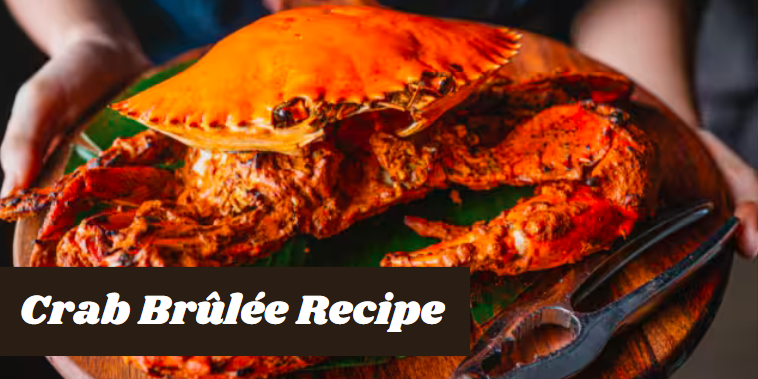Contents
Introduction to Crab Brûlée
Crab brûlée is a unique and delightful seafood dish that combines the rich, savory flavors of fresh crab meat with a sweet and crispy caramelized sugar crust. This fusion of flavors creates a gourmet experience that is sure to impress your guests and satisfy your taste buds.
While traditional crème brûlée is a classic French dessert made with vanilla custard, this seafood variation brings a whole new dimension to the table. In this comprehensive guide, we will explore the art of making the perfect crab brûlée, delve into its history, and provide tips and tricks to elevate your culinary skills.
The Origin and Evolution of Crab Brûlée
Historical Background
The origins of crème brûlée can be traced back to France in the 17th century, where it quickly became a popular dessert. The combination of a creamy custard base and a hard caramelized sugar topping was an instant hit. However, the concept of crab brûlée is a more modern innovation, born out of the desire to experiment with savory flavors in traditionally sweet dishes. This innovative approach has led to a fascinating evolution of the dish, making it a staple in contemporary seafood cuisine.
Modern Adaptations
Today, crab brûlée has found its place in the menus of upscale restaurants and gourmet kitchens. Chefs and home cooks alike have embraced the challenge of balancing the delicate sweetness of the brûlée with the savory richness of crab meat. This dish is a testament to the creativity and versatility of modern culinary arts.
Ingredients for the Perfect Crab Brûlée
Freshness is Key
When it comes to making a delectable crab brûlée, the quality of your ingredients is paramount. Here’s a list of the essential ingredients you’ll need:
- Fresh Crab Meat: Opt for fresh, lump crab meat for the best flavor and texture. You can use either blue crab or Dungeness crab, depending on what’s available in your region.
- Heavy Cream: This forms the creamy base of the brûlée.
- Egg Yolks: These provide the custard with its rich, velvety texture.
- Shallots: Finely chopped shallots add a subtle sweetness and depth of flavor.
- Garlic: A hint of garlic complements the crab meat beautifully.
- White Wine: Adds a touch of acidity and enhances the overall flavor profile.
- Butter: Used for sautéing the shallots and garlic.
- Salt and Pepper: Essential for seasoning.
- Granulated Sugar: For the caramelized topping.
- Chives or Dill: For garnish, adding a fresh, herbaceous note.
Optional Ingredients
To add your own twist to the recipe, consider incorporating the following optional ingredients:
- Lemon Zest: Adds a refreshing citrus note.
- Parmesan Cheese: For a cheesy twist.
- Hot Sauce: For a bit of heat.
- Truffle Oil: For an indulgent, earthy flavor.
Step-by-Step Guide to Making Crab Brûlée
Preparation
- Preheat the Oven: Preheat your oven to 325°F (163°C).
- Prepare the Ramekins: Place six 6-ounce ramekins in a large baking dish.
Making the Custard Base
- Sauté the Shallots and Garlic:
- In a medium skillet, melt 2 tablespoons of butter over medium heat.
- Add finely chopped shallots and garlic, and sauté until translucent and fragrant, about 3-4 minutes.
- Add the Crab Meat:
- Add the fresh crab meat to the skillet and cook for another 2 minutes.
- Deglaze the skillet with white wine and cook until the liquid has mostly evaporated.
- Season with salt and pepper to taste, and set aside to cool slightly.
- Prepare the Cream Mixture:
- In a medium saucepan, heat the heavy cream over medium heat until it begins to simmer. Do not let it boil.
- In a separate bowl, whisk the egg yolks until they are well blended.
- Combine the Ingredients:
- Slowly pour the hot cream into the egg yolks, whisking constantly to prevent the eggs from curdling.
- Once fully combined, add the crab mixture to the cream and egg yolk mixture.
Baking the Crab Brûlée
- Fill the Ramekins:
- Evenly distribute the crab mixture among the prepared ramekins.
- Create a Water Bath:
- Pour hot water into the baking dish around the ramekins until it reaches halfway up the sides. This water bath helps to cook the custard evenly and prevents it from cracking.
- Bake:
- Carefully transfer the baking dish to the preheated oven and bake for 40-45 minutes, or until the custard is set but still slightly jiggly in the center.
Caramelizing the Sugar
- Cool and Chill:
- Remove the ramekins from the water bath and let them cool to room temperature.
- Once cooled, refrigerate the brûlées for at least 2 hours, or overnight.
- Caramelize the Sugar:
- Just before serving, sprinkle a thin, even layer of granulated sugar over each custard.
- Using a kitchen torch, carefully caramelize the sugar until it forms a golden brown, crispy crust. Alternatively, you can place the ramekins under a broiler for a few minutes, but watch them closely to prevent burning.
Garnish and Serve
- Garnish:
- Garnish each brûlée with freshly chopped chives or dill for a pop of color and flavor.
- Serve:
- Serve immediately to enjoy the contrast between the creamy custard and the crunchy sugar topping.
Tips and Tricks for the Best Crab Brûlée
Choosing the Right Crab
- Fresh vs. Frozen: While fresh crab meat is ideal for the best flavor, high-quality frozen crab meat can be a good alternative if fresh crab is not available. Just make sure to thaw it properly and drain any excess moisture.
- Picking the Meat: When using whole crabs, take your time to carefully pick through the meat to remove any shell fragments. This ensures a smooth and pleasant eating experience.
Perfecting the Caramelization
- Even Layer of Sugar: For a perfect caramelized crust, make sure to sprinkle an even layer of sugar over the custard. Too much sugar can result in a thick, burnt crust, while too little may not caramelize properly.
- Using a Kitchen Torch: A kitchen torch gives you more control over the caramelization process compared to a broiler. Move the torch in a circular motion to evenly melt the sugar without burning it.
Enhancing the Flavor
- Balancing Sweet and Savory: The key to a delicious crab brûlée is balancing the sweet caramelized sugar with the savory crab custard. Taste and adjust the seasoning of the custard base to achieve the perfect harmony.
- Adding Aromatics: Incorporating aromatics like lemon zest or truffle oil can elevate the dish and add complexity to the flavor profile.
Pairing Crab Brûlée with Other Dishes
Appetizers and Salads
- Light Salads: A light, citrusy salad can be a refreshing complement to the rich crab brûlée. Consider a simple arugula and fennel salad with a lemon vinaigrette.
- Seafood Appetizers: Other seafood appetizers, like shrimp cocktail or smoked salmon, can create a cohesive seafood-themed meal.
Main Courses
- Grilled Fish: A main course of grilled fish, such as salmon or halibut, pairs well with the delicate flavors of crab brûlée.
- Pasta Dishes: Creamy pasta dishes, like fettuccine Alfredo or seafood linguine, can enhance the luxurious experience of the meal.
Beverages
- White Wine: A crisp, chilled white wine, such as Chardonnay or Sauvignon Blanc, complements the richness of crab brûlée.
- Champagne: For a celebratory touch, serve crab brûlée with a glass of champagne.
FAQs About Crab Brûlée Recipe
What is Crab Brûlée?
Crab brûlée is a savory twist on the classic crème brûlée dessert. It features a rich custard base made with fresh crab meat, topped with a caramelized sugar crust. This dish combines the sweetness of the brûlée with the savory flavors of crab, creating a unique and delightful culinary experience.
Can I Use Imitation Crab Meat for Crab Brûlée?
While imitation crab meat can be used as a substitute, it may not provide the same depth of flavor and texture as fresh crab meat. For the best results, use fresh or high-quality frozen crab meat.
How Do I Store Leftover Crab Brûlée?
Leftover crab brûlée can be stored in the refrigerator for up to 2 days. Cover the ramekins with plastic wrap or aluminum foil to prevent them from absorbing any odors from the fridge. Reheat gently in a preheated oven at 300°F (150°C) until warmed through.
Can Crab Brûlée Be Made Ahead of Time?
Yes, crab brûlée can be made ahead of time. Prepare and bake the custard base, then chill in the refrigerator. Just before serving, sprinkle the sugar and caramelize it with a kitchen torch or broiler.
What Can I Use If I Don’t Have a Kitchen Torch?
If you don’t have a kitchen torch, you can caramelize the sugar under a broiler. Place the ramekins on a baking sheet and position them under the broiler. Keep a close eye on them and rotate as needed to ensure even caramelization without burning.
Conclusion
Crab brûlée is a gourmet seafood dish that brings together the best of sweet and savory flavors. By following this comprehensive guide, you can create a restaurant-quality crab brûlée in the comfort of your own kitchen.
Experiment with different ingredients and techniques to make the recipe your own, and enjoy the compliments from your guests as they savor this unique and delightful dish. Whether for a special occasion or a sophisticated dinner at home, crab brûlée is sure to impress and satisfy.




